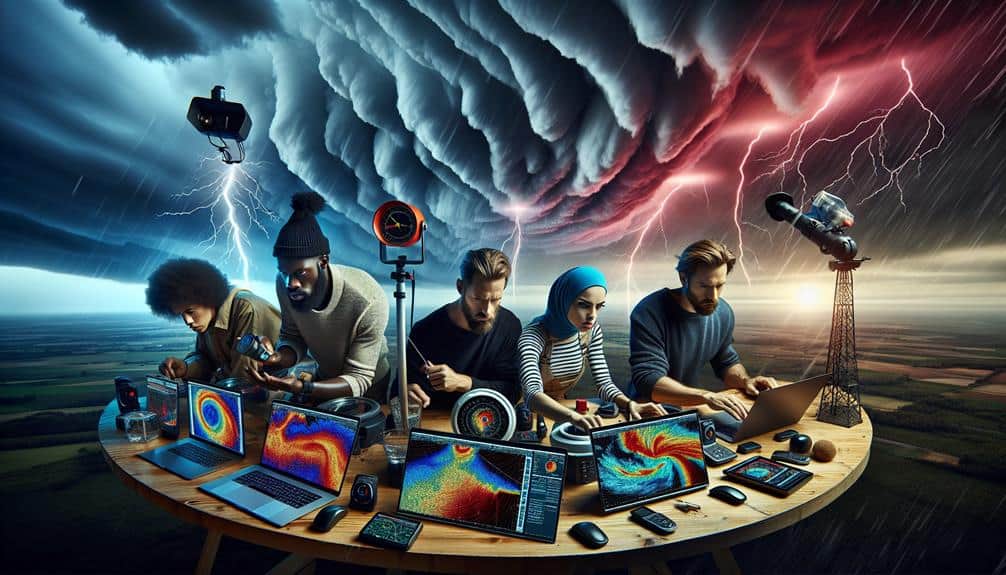We've discovered that the top storm tracking software for storm chasers includes RadarScope and WeatherLab, both recognized for their reliability and ease of use. RadarScope offers precise radar data and real-time updates, while WeatherLab incorporates various data sources and customizable overlays. For chasers on a budget, MyRadar and NOAA Weather Radar Live offer exceptional free choices. Premium tools like WeatherLab excel in accuracy with advanced storm prediction models and real-time alerts. Mobile apps with GPS precision guarantee informed decision-making on the go. Delve deeper to explore how these tools can enhance your storm chasing experience.
Key Points
- Radarscope and WeatherLab are highly praised for reliability and ease of use in storm tracking.
- Windy and MyRadar offer real-time updates and detailed satellite imagery, excelling in user customization.
- Premium tools provide advanced features like storm prediction models, historical data analysis, and real-time alerts.
- Mobile apps ensure GPS accuracy, real-time updates, and immediate action through notifications during severe weather conditions.
Best Overall Storm Trackers
When evaluating storm tracking software, we've identified several top-tier options that offer robust features, high accuracy, and user-friendly interfaces. For storm chasers who value both freedom and precision, these tools are indispensable.
First, let's delve into an accuracy comparison. Radarscope stands out with its pinpoint radar data and real-time updates, ensuring we stay ahead of rapidly changing weather conditions. Similarly, GRLevel3 offers high-detail radar imagery, making it a strong contender in our feature comparison.
Next, let's examine feature comparison. Storm chasers need tools that provide not just radar images, but also storm attributes, warning polygons, and lightning data. WeatherLab excels here by integrating multiple data sources and offering customizable overlays. On the other hand, MyRadar provides a streamlined interface with essential storm tracking features, making it particularly user-friendly.
User reviews consistently highlight the reliability and ease of use of these tools. Radarscope users praise its detailed radar imagery, while WeatherLab earns high marks for its all-encompassing data integration.
Importantly, customer support for these platforms is robust, with Radarscope offering extensive online resources and GRLevel3 providing responsive email support.
Top Free Tracking Tools
In addition to premium options, we also find several free storm tracking tools that provide reliable data and essential features for storm chasers. One standout is the NOAA Weather Radar Live app. It offers real-time updates and high-resolution satellite imagery, ensuring we don't miss critical storm developments. The data accuracy is commendable, making it a trusted resource.
Another invaluable tool is Windy, which excels in user customization. We can tailor the display to show specific weather parameters, enhancing our storm tracking precision. Windy's integration of real-time updates and detailed satellite imagery helps us stay ahead of severe weather conditions.
RadarScope's free version also deserves mention. While it lacks some advanced features of its premium counterpart, it still provides excellent radar data. Its data accuracy and real-time updates are particularly useful for those of us needing reliable information on the go.
Lastly, MyRadar is an intuitive app that combines real-time updates with clear satellite imagery. Its straightforward user interface allows for quick customization, making it easy to focus on the most relevant storm data. These free tools collectively empower us to track storms effectively without financial constraints.
Premium Tracking Software
For those of us demanding advanced features and detailed data, premium storm tracking software offers unparalleled precision and customization. These sophisticated tools provide real-time alerts, ensuring we're always ahead of the storm. With high-resolution radar imagery and customizable layers, we can analyze weather patterns with pinpoint accuracy. The software's advanced features include storm prediction models, historical data analysis, and multi-device synchronization, allowing us to access essential information wherever we are.
One standout feature is the integration of real-time alerts. These notifications aren't just timely but customizable based on our specific criteria, such as storm type, wind speed, and proximity. This level of detail empowers us to make informed decisions swiftly, enhancing both our safety and effectiveness in the field.
Additionally, premium software often includes advanced mapping tools that allow us to visualize storm paths and potential impact zones. This is vital for planning our routes and positioning ourselves strategically. The inclusion of social sharing tools also means we can quickly disseminate crucial information to our network.
Mobile Storm Tracking Apps
How do mobile storm tracking apps enhance our ability to monitor severe weather events on the go?
First, they provide real-time updates, ensuring we're always informed about the latest developments in storm activity. This capability is essential for storm chasers who need to make split-second decisions based on the most current data available.
The integration of GPS accuracy in these apps allows us to pinpoint our exact location relative to the storm, enhancing our situational awareness and safety.
Furthermore, mobile storm tracking apps incorporate advanced storm prediction algorithms. These tools analyze vast amounts of meteorological data to forecast storm paths and intensity, giving us a critical advantage in planning our routes and staying out of harm's way.
Safety features in these apps, such as real-time alerts and notifications, keep us informed about severe weather conditions, helping us take immediate action to protect ourselves and our equipment.
The portability of mobile apps means we're no longer tethered to a stationary setup. This freedom allows us to pursue storms with greater agility and precision.
User-Friendly Interfaces

Why do user-friendly interfaces matter so much in mobile storm tracking apps? As storm chasers, we need to make rapid decisions based on complex data. A user-friendly interface ensures that we can swiftly access real-time updates, personalize the interface to suit our specific needs, and integrate maps effortlessly.
Interface customization plays a pivotal role in our work. By adjusting the display settings, we can prioritize the most vital data, enhancing our situational awareness. Real-time updates keep us informed of the latest weather developments, allowing us to adjust our plans without delay.
Map integration is another essential feature. High-quality map integration allows us to visualize storm paths and potential impact zones with precision. This functionality, combined with advanced data visualization techniques, enables us to interpret weather patterns and make informed decisions quickly.
Effective data visualization transforms raw data into clear and actionable insights. It's not just about attractive graphics; it's about making complex meteorological data understandable and accessible at a glance.
Frequently Asked Questions
What Data Sources Do Storm Tracking Software Typically Utilize?
Satellite imagery and sophisticated radar data serve as vital sources. We rely on them to predict storm patterns, ensuring precise tracking. This data-driven approach empowers us with the freedom to anticipate and act swiftly.
How Can Storm Tracking Software Improve Safety for Storm Chasers?
Storm tracking software improves safety benefits by providing real-time tracking of storm systems. We can make informed decisions, evade hazardous areas, and optimize our routes, ensuring our safety while pursuing our passion for storm chasing.
Are There Community Forums or Support Groups for Users of Storm Tracking Software?
Yes, we can find online forums and user groups dedicated to storm tracking software. These support networks and community resources offer valuable insights, technical support, and data-driven discussions, enhancing our engagement and knowledge-sharing.
What Hardware Requirements Are Necessary for Running Advanced Storm Tracking Software?
We need to meet the minimum requirements of 8GB RAM and an i5 processor, but we recommend specifications like 16GB RAM and an i7 for best performance. High-speed internet and dedicated graphics enhance our tracking capabilities greatly.
How Do Storm Tracking Apps Handle Data Privacy and User Information Security?
In the eye of privacy concerns, we guarantee storm tracking apps implement robust security measures. Apps encrypt data, anonymize user information, and regularly update protocols, giving us the freedom to chase storms without compromising our privacy.

